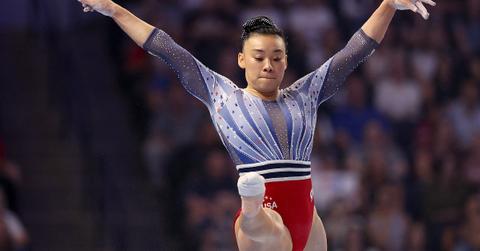Gymnasts Can Do the Impossible — Some Do It With the Help of a Sock
Gymnasts can do anything. But sometimes, they need a little help from their socks. We explain why.
Jul. 3 2024, Published 3:00 a.m. ET

No one can argue that Simone Biles is historic — after qualifying for her third Olympics after the USA Olympic trials, she’ll be the oldest gymnast to compete at the highest level since the 1950s at 27 years old. As viewers watched Simone make history at the trials, we also noticed that several gymnasts wore just one sock.
From the balance beam to the floor, a few of the 10 competing gymnasts vying for the top five spots at the Olympics were noticeably wearing one sock. For non-gymnasts who just enjoy watching the impressive acrobatics, this can be confusing. But for those of us in the know, we have answers as to why gymnasts will sometimes wear one sock.

Some gymnasts wear only one sock to help facilitate turns and avoid broken toes.
Gymnastics has been top of mind since Simone rose up during the 2016 Olympic games. Her expert Wolf Turn on the balance beam has brought the nearly impossible move back to the surface after it went out of fashion for many years. When performing it, gymnasts turn in a squat with one leg extended out, similar to a tuck spin in ice skating, but without the velocity provided by the ice.
The turn is considered one of the most difficult in gymnastics because it changes the center of gravity, messes with the axis of rotation, and requires insane glute strength to keep the extended leg out. The most skilled gymnasts can do a Double or even Triple Wolf Turn to score higher points. However, friction with the balance can make these turns, and other turns like it, even more difficult.

Gymnasts and other athletes often use rosin to avoid too much friction and slipperiness. However, that doesn’t always do the trick for turns, especially on the balance beam. Because of this, some gymnasts wear one sock to help facilitate difficult turns. If gymnasts sweat a lot, the rosin can get too sticky and make turns more difficult, so a sock allows the gymnasts to turn without getting stuck or catching their toes.
Two socks, on the other hand, would make both feet too slippery without providing enough stability. Performing barefoot is essential in gymnastics — it helps gymnasts ground themselves with their apparatuses and make smoother landings. It’s imperative that gymnasts are able to feel the surface beneath them so that they can have complete control over the lead-in to a flip or other complicated trick.
Most gymnasts are actually wearing a toe shoe, not a sock.
If you look closely, you can see gymnasts aren’t wearing a regular sock. They tend to wear toe shoes, which are commonly worn by rhythmic gymnasts (because they turn more frequently). Toe shoes cover just the toe and have elastic bands to keep it in place so the heel is still exposed to the ground or beam.
Of course, the Olympic committee has rules and regulations about what gymnasts can and cannot wear. They are permitted to wear, one sock "to a maximum size of 10cm2.” While gymnasts can use these toe shoes for turns, other gymnasts are sometimes seen wearing a bandage that looks like a sock.
During the United States 2024 Olympic trials, Jordan Chiles was seemingly wearing a sock during the balance beam event. However, on closer inspection, she was actually wearing a compression bandage, typically used for inflammation or stability if there’s a minor injury. So if you see your favorite gymnasts wearing a compression bandage, let’s hope that they’re still in tip-top shape!